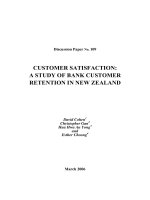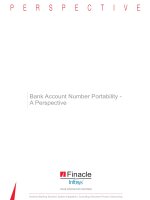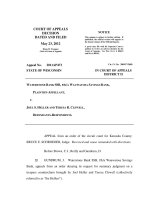Bank Account Number Portability - A Perspective pot
Bạn đang xem bản rút gọn của tài liệu. Xem và tải ngay bản đầy đủ của tài liệu tại đây (327.58 KB, 9 trang )
Business Process OutsourcingConsulting
System Integration
Universal Banking Solution
Bank Account Number Portability -
A Perspective
Bank Account Number Portability - A Perspective 1
1. Background 3
Switching banks versus maintaining multiple banking relationships -
Options available to customers 3
1.1 Change of bank 3
1.2 Multiple banking relationships 4
2. Portability of services in banks 4
3. Bank Account Number Portability (BANP) - Need of the moment 4
4. BANP- How does it works? 4
4.1 The stake holders involved in the process 5
4.2 BANP Process Flow 5
5. BANP impact on business processes 6
5.1 Across the counter transactions 6
5.2 Clearing transactions 6
5.3 ATM and Point of Sale Transactions 6
6. Bank Account Number Portability- Trends in global markets 6
7. Prerequisites, business challenges for BANP 7
7.1 Challenges 8
8. Conclusion 8
9. References 8
BANK Account Number Portability-
A Perspective
1. Background
Switching banks versus maintaining multiple
banking relationships - Options available
to customers
Trust and service form the bedrock of the
relationship between a bank and a customer.
Besides these, other factors like pricing and
convenience influence the customer’s choice
of banking service provider.
It is observed that customers are increasingly
banking with multiple institutions for various
reasons, ranging from deterioration in
service extended by their current main bank
to a change in professional and personal life
circumstances.
While the majority of customers prefer to
associate with a single bank so that they
can leverage the relationship value to secure
better pricing, and also for sheer convenience,
they are forced to use multiple providers to
satisfy their needs.
Against this backdrop, a facility, which allows
customers to retain their existing bank
account numbers when they change their
bank, would make the switch easier. This
is the principle underlying Bank Account
Number Portability (BANP).
This thought paper is an attempt to
understand BANP as a technology, its
s i g n i f i c a n c e , b u s i n e s s i m p l i c a t i o n s ,
implementation challenges etc. While BANP
is a reality in some countries around the world,
it is yet to catch up in others.
Customers switch banks not only when they
feel that service has worsened or the bank’s
pricing policy lacks transparency, but also
when there is a change in personal and
professional circumstances, such as a change
of residence or salary account. At other times,
they switch banks in order to avail of better
leveraging opportunities and promotional
offers or a wider channel selection.
The switch can happen in two ways – by
moving a current banking relationship to a
new bank or starting a new relationship with it.
While customers have a wide selection of
banks today, they must weigh the pros and
cons of an alternative banking relationship
with each institution before making a choice.
When customers terminate an existing
banking relationship to open a new one
with another bank, they need to consider
the following:
• The process of replacing / updating
in-bound and out-bound payment
mandates issued to Banks / Financial
Institutions / Government Departments/
Mutual Funds etc.
• The financial cost of terminating the
relationship, which multiplies when
bundled products held with the current
bank need to be broken. But, most
customers are not aware of the real cost
of their existing banking relationships,
and are therefore not in a position to
compare costs correctly while switching.
Rather than terminate their existing
relationship, some customers prefer to
start a new one at another bank especially
when they have secured attractive terms
on a bundled product, are unable to
arrive at the cost of an isolated product
offering, or when the cost of terminating
the relationship is high.
Due to the above reasons, even
after entering into a new relationship,
customers hold on to their old banking
relationships despite being dissatisfied
with them, till such time that all obligations
are discharged. The hassle of switching is
a compounding factor.
Clearly, it is not optimal for customers to
manage multiple relationships. If BANP
becomes available, it will be much easier
for customers to move their business to
another bank.
1.1 Change of bank
1.2 Multiple Banking relationship
Bank Account Number Portability-
A Perspective
3
2. Portability of services in Banks
3. Bank Account Number Portability (BANP) -
Need of the moment
4. BANP- How does it work?
Portability of services in banking refers to the
extension of services to the customers of
other banks. As ATM/POS networks grew,
banks offered this facility – albeit limited – to
improve convenience, and reduce the
dependence of customers on the network of
their main bank. Currently, a few services,
such as balance enquiry, cash withdrawal,
POS payments through ATMS and EDC
machines, are portable. Portability of services
differs from bank account number portability
in that it involves extending a service without
owning an account. Portability of banking
services can be compared to the agreement
between network operators to allow the other’s
“roaming” customers to use their network.
A mature service industry empowers
customers to change service providers without
inconvenience or loss; the goal should be to
accord banking customers the same privilege
through bank account number portability.
Doing so will also boost competition in retail
financial services markets and force banking
players to continuously improve performance.
In some countries like India, regulators are
expected to allow banks the freedom to
determine the interest rate on savings
accounts. If banks take this as an opportunity
to roll out an array of structured saving
products for different customer segments, it
might create another point of differentiation
and motivate customers to switch banks.
That being said, any measure to induce
competition through switching will not be
effective unless it is hassle free for customers.
The principle requirement of processing
transactions with bank account number
portability is to be able to identify the account
number and the bank owning the account.
Efforts have been made (especially in
European & North American countries) to
standardize the allocation of unique account
numbers as a combination of bank and
branch code so that the account number
itself indicates the bank and branch that own
the account. This has made processing of
payment transactions easy, as there is no
need to specify the beneficiary bank details
every time a payment instruction is processed.
On the flip side, as the account number
reflects the original bank and branch, any
subsequent change requires a new account
number reflecting the new bank and branch.
The other problem is that this system will not
work in countries where there is no standard
pattern of account numbering and since it
would take huge effort to regenerate / map all
the existing numbers with the global standard
pattern, it is unlikely that these countries
would adopt it.
But in countries with standardized account
numbering, the implementation of BANP
calls for maintaining an up-to-date, centralized
database of all bank account numbers and
making it available to all banking institutions.
A suitable clearing house agency must be
entrusted with the management of this
database, including attending to porting and
de-porting requests from member banks.
In vast countries, such as India, the database
could be partitioned by service/geographic
areas, as defined by the regulator and scope
of BANP implementation.
All the member banks would be required to
have a local database - a real time replica
of the central database (updated at a
pre-determined frequency) - of ported bank
account numbers to initiate porting and
de-porting requests and to receive associated
messages. Banks could also use the local
database for internal queries/ operations,
and therefore not have to rely on the
central database.
The clearing house shall facilitate exchange
of porting messages among participating
banks, validate these messages, and notify
all ported numbers and their associated
routing information to the banks. Consequent
to this, banks would have to either update or
open the ported accounts in their Core
Banking Solutions depending upon their role
as old or new serving banks respectively.
Bank Account Number Portability-
A Perspective
4
4.1 The stake holders involved in the process
4.2 BANP process flow
Customer: The customer enjoying the
banking relationship
Donor Bank: The first bank of the
customer
New Serving Bank: The bank, which will
serve the customer consequent to the
porting request
Old serving Bank: The customer’s bank
prior to the porting request. For the first
porting request, the donor and the old
serving bank are obviously the same.
They become different for subsequent
porting requests.
Clearing House: The agency, which
owns the central database of ported
bank account numbers, handles porting
requests from member banks and advises
them of porting results.
The customer initiates the bank account
number portability service process with
the new acquiring bank (In case the
BANP request is initiated with the old
serving bank, it might create some
hurdles in order to retain the customer).
The new acquiring bank, after scrutinizing
the application and ensuring KYC
process compliance, initiates a porting
request through its local database
interface with the central database of
bank account numbers. The new
acquiring bank must check that there
is no duplication of account numbers,
because it is quite possible that different
banks in different geographies have
assigned the same number. The clearing
agency, which owns the central database
of ported bank account numbers, sends
a porting out request to the old serving
bank along with the customer’s details.
The old serving bank, after going through
its closure checklist (to check for pending
instruments, dues outstanding, if any,
cancellation of ATM/ Debit card, interest
calculation till date etc.,) closes/ marks
the account as a ‘ported out account’
and remits the proceeds to the new
acquiring bank with porting confirmation
to the clearing agency.
The BANP process is outlined in the
diagram below:
Bank Account Number Portability-
A Perspective
Central Database
of Ported Bank
Account Numbers
Local Database
(Old serving Bank)
of Ported Bank
Account Numbers
Old serving Bank
Receipt of Porting
out request
Porting out check
list and process
initiation
Porting out request
processed
Closure Proceeds
Customer
Acquiring Bank
Application
security and KYC
Process initiation
Local Database
(New serving
Bank) of Ported
Bank Account
Numbers
Remitance
Confirmation
5
5. BANP impact on business processes
The most common debit instruments that
customers use to raise a withdrawal demand
are the ATM/Debit card and the cheque. Both
are issued by the bank and are non-
transferable.If the acquiring bank has to
reissue a debit card and cheques to the
customer, it would create administrative and
procedural hurdles for all concerned. Ideally,
the new bank must be able to process
withdrawal demands raised by the customer
using debit instruments issued by the old
serving banker.
Business processes pertaining to certain
banking transactions need to be changed in
order to support seamless customer service
after BANP implementation. We examine
herewith the possible changes in business
processes for across the counter and ATM/
Debit card/payment transactions.
Proposed changes to business processes
after the implementation of BANP:
Major changes are not envisaged for
business processes pertaining to across
the counter transactions. Core banking
solutions would need to identify the
ported in and ported out account numbers.
Most core banking solutions enable
banks to classify accounts based on their
status codes, which are bank definable.
Clearing is one of the operations, which
will be impacted the most as a result
of BANP implementation. The clearing
process can be handled in any of the
following ways:
• Extinguishing all unused cheque
books and cheques already issued
but not presented for payment before
BANP takes effect, and treating
cheques presented after BANP takes
effect in the same way as inward
cheques of a closed account. This
appears to be impractical considering
that customers would have issued a
5.1 Across the counter transactions
5.2 Clearing transactions
number of Post Dated Cheques to
service their loans.
• A framework wherein a presenting
bank identifies the cheques drawn on
ported account numbers from the
outward lot, using the local database
of ported numbers, and re-directs the
demand to the new acquiring bank.
• In case of inbound and outbound
electronic clearing settlements,
payment mandates on ported
account numbers are identified and
the mandates re-directed to their
respective new acquiring banks.
Suitable interfaces (online or batch)
to local ported account number
databases - depending upon whether
the payment system is of net or gross
settlement type - are required.
The ATM/Debit card is a common
instrument of electronic payment and
withdrawal. The card is the property of
the issuing bank and is nontransferable.
Once an account is ported to another
bank, the customer has to apply to it for
a new ATM/Debit card. To continue
operations with the old ATM/Debit card
would necessitate change of business
processes at the payment switch level to
redirect requests to the new serving bank,
which would involve huge effort.
Bank account number portability is already
in place in regions such as Europe and
Australia in different forms. In the United
States, every bank account number indicates
the bank and pin code of the branch owning
the account. However, the mechanism to
handle subsequent bank switches is still not
in place. The account number has to be
updated in all the direct debit obligations for
routing payment requests to the new bank.
Europe has made significant progress in
the implementation of customer mobility
solutions. However, the methodology and
framework differ across European countries.
6. Bank Account Number Portability- Trends in
global markets
5.3 ATM and Point of Sale Transactions
Bank Account Number Portability-
A Perspective
6
Sweden has the ‘Bankgiro’ system, which is
more of a number portability system than a
bank account number portability system. A
Bankgiro number – which is similar to an
IBAN number – connects the bank and its
account numbers. Customers need only
mention their Bankgiro number for payment
mandates, and the beneficiary bank directs
the credit to the connected account.
In Sweden, while the Bankgiro number is
portable, the underlying account number is
not. So, when a customer switches his bank,
he can retain the same Bankgiro number,
but needs to open a fresh account with the
new bank and link the Bankgiro number with
the new account.
Although the Bankgiro works well in a
country, which transacts mainly using
electronic payments rather than physical
instruments, it comes with some limitations.
The system can only be used for crediting
(as opposed to debiting) accounts that are
linked to only one payment system. Also, the
Bankgiro system is currently only offered to
corporate clients.
Other European countries also have
customer mobility, although they use different
methodologies and have achieved different
levels of progress.
In the United Kingdom, BACS is a nonprofit
membership based industry body owned by
15 banks, responsible for clearing and
settlement of automated payments. It serves
as the re-router of direct debits for
ported accounts.
The old serving bank provides the new one
with information on the customer’s standing
and debit mandate orders within three
working days of receiving the request from
the latter. The new serving bank then provides
the same information to the customer for
confirmation and activates all previous
standing and debit orders. Now, the customer
may close the account with the old bank.
BACS then redirects all the customer’s debit
orders to the new bank. Although BACS
does not provide true account number
portability, it enables the customer’s debit
orders to be serviced by the new bank.
In Europe, although portability of account
numbers is yet to be achieved, it already
exists for debit mandates, thereby freeing the
customer of the hassle of closing mandates
at the old bank and re-opening the mat the
new one.
However, countries that still have a huge
number of transactions happening over
paper based clearing systems, must extend
the above mechanism to cater to their clearing
and settlements.
Before BANP is made available to customers,
it is very important that the banking
sector gear itself for its challenges and
inherent risk-reward matrix. Some of the
prerequisites of BANP implementation are
outlined hereunder:
• Since many customers switch banks for
convenience of location and transparent
pricing, banks must neutralize these
factors by offering efficient delivery
channel services and better pricing
information. They must equip themselves
with adequate IT infrastructure to
augment the capabilities of delivery
channels and pricing engines.
• While on the subject of pricing
transparency, it is very difficult for
customers to ascertain the price of
individual products that make up a
product bundle. It is therefore necessary
to regulate price disclosure by different
banks, or set up an industry body
that publishes the accurate price of
various products.
• Some global payment types require
accounts to be numbered according
to IBAN standards. The impact of BANP
on these payment systems needs to
be studied.
• Banks must prepare to make changes
to their Core Banking Solutions/ Legacy
7. Prerequisites, business challenges for BANP
Bank Account Number Portability-
A Perspective
7
A
uthor
Manish Jain
Kumar Kudidhi
Industry Principal, Finacle
Infosys Limited
Lead Consultant, Finacle
Infosys Limited
Systems in order to support account
number porting.
• The rollout of a centralized transactional
banking platform is essential for BANP
to work.
• Banking regulations may require
changes, especially in the area of
negotiable instruments (to cover
situations when the drawee bank is
different from the payee bank for cheques
issued prior to a porting request).
• Payment settlement processes with
respect to channels may also need
changes.
• Few customers might switch banks
repeatedly to escape the net of Anti
Money Laundering regulation. In their
eagerness to attract new customers,
banks must not overlook due diligence
at the time of onboarding. Accordingly,
AML and Know Your Customer (KYC)
regulations must provide clear directives
on how to spot genuine switchers from
those with vested motives.
Business Benefits
• BAN P is ex pect ed to stimul ate
competition among banks and offer a
potential upside to those maintaining
consistency in customer service and
transparency in pricing.
• It will provide an easy way to acquire
profitable customers and let goof
unprofitable accounts.
• It will give banks an opportunity to
increase their share in saturated markets.
• BANP will enhance competition
among banks to acquire customers
and therefore increase the cost of
acquisition and service.
• BANP could drive customers of
banks with inadequate service and
marketing to relatively stronger banks.
Smaller and weaker banks will have
7.1 Challenges
to focus on customer segmentation
and product offerings to retain their
customer base.
• With deregulation of savings account
interest rates round the corner, banks
will be forced to hike yields and
absorb the higher overall cost of funds.
• Banks will need to provide for heavy
initial investment and service costs
to set up BANP IT infrastructure. They
will also need to train staff on the
changed business processes.
• There will be concerns around IT
security and confidentiality of client
information since the central database
of ported numbers will be available
to all member banks. Accordingly,
appropriate access rights need to
be defined.
Banking experts across the globe are of
the view that customer mobility will enhance
competition in the retail banking space.
Bank account number portability encourages
banks to be more focused on customer
service and most importantly, transparent
in pricing. The customer should be free to
choose a bank for its product, notwithstanding
a pre-existing bundled product relationship
with another bank. There is also a need for
an efficient industry body, which compels
banks to provide accurate information on
pricing so that the customer can make a
sound financial judgment before switching a
banking relationship.
1. www.bgc.se/Default____5057.aspx
8. Conclusion
9. References
Bank Account Number Portability-
A Perspective
8









